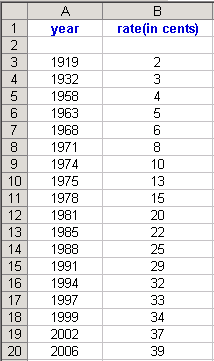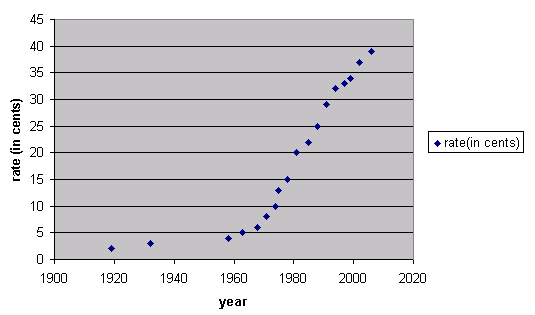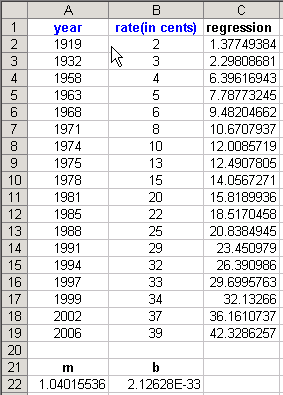 |
 |
Part C: The Stamp Problem
C. Consider the Stamp Problem in Assignment 12. Update the data to include the price increases for a first class letter through January 2006 -- when the price will become 39 cents. (Recent increases were 33 cents in 1997, 34 cents in 1999, and 37 cents in 2002.) Prepare a write-up and use your analysis to answer the questions anew:
When will the cost of a first class postage stamp reach $1.00?
When will the cost be 74 cents?
How soon should we expect the next increase?
In 1996, the analysis of stamp data historically seemed to show that the postage doubled every 10 years approximately. The cost in 2006 would seem to argue that pattern is no longer valid. Is there evidence to show a change in the growth pattern? Or, was the 'doubles every ten years' just a bad model?
The following table show the most recent stamp prices for a first class letter, which has shown a steady rise since the beginning of 20th century.
 |
 |
If we are to include all of the data in our regression, it certainly doesn't look like we will fit the data to a line (although from the 70s on, the data looks like it may be leveling out.) I'm no economist, but I believe this type data, which is probably closely related to inflation, usually ends up being exponential. Using Excel's LOGEST function, I got the following output (using this .xls file):
 |
The regression equation is of the form RATE = b*m^YEAR. The value for m is in cell A22 = 1.04015536 The regression equation is thus RATE = 2.12628E-33 * 1.04015536^YEAR
|
To find out when a stamp would cost one dollar, we would need to solve the equation:
100 = 2.12628E-33*1.04015536^YEAR
YEAR = 2027.836643
Similarly, to find out when the cost will be 74 cents:
74 = 2.12628E-33*1.04015536^YEAR
YEAR = 2020.188575
Good thing we have email, huh?
In 1996, one prediction was that the price of stamps would double every ten years. Let's see if this agrees with our regression equation. Our regression equation predicts the following prices for years that are multiples of ten:
YEAR |
Predicted Cost |
1990 |
22.55 |
2000 |
33.42 |
2010 |
49.55 |
2020 |
73.45 |
If the trend marked by our regression equation hold, the data isn't quite doubling every ten years.